Input interpretation

organidin
Chemical names and formulas
![formula | C_6H_11IO_3 name | organidin IUPAC name | [2-(2-iodoethyl)-1, 3-dioxolan-4-yl]methanol alternate names | 2-(1-iodoethyl)-1, 3-dioxolane-4-methanol | iodinated glycerol mass fractions | C (carbon) 27.9% | H (hydrogen) 4.3% | I (iodine) 49.2% | O (oxygen) 18.6%](../image_source/663d4f526946d1a3cb0ed0678cc701f7.png)
formula | C_6H_11IO_3 name | organidin IUPAC name | [2-(2-iodoethyl)-1, 3-dioxolan-4-yl]methanol alternate names | 2-(1-iodoethyl)-1, 3-dioxolane-4-methanol | iodinated glycerol mass fractions | C (carbon) 27.9% | H (hydrogen) 4.3% | I (iodine) 49.2% | O (oxygen) 18.6%
Lewis structure
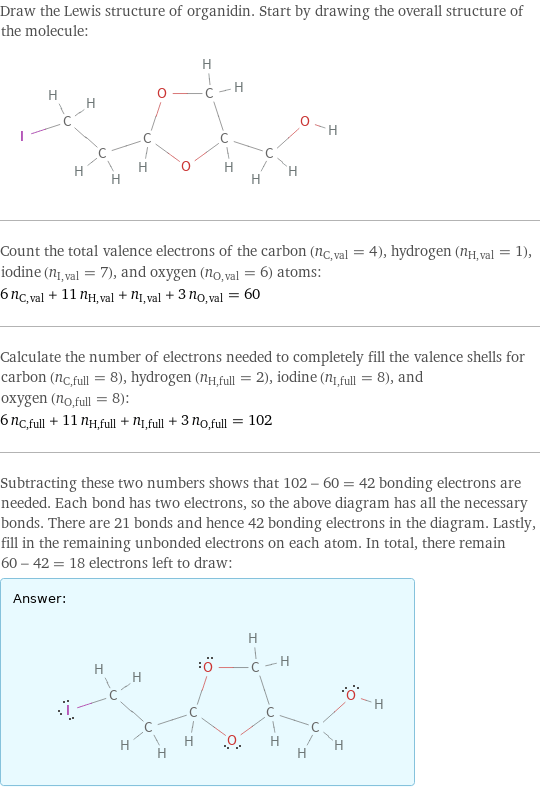
Draw the Lewis structure of organidin. Start by drawing the overall structure of the molecule: Count the total valence electrons of the carbon (n_C, val = 4), hydrogen (n_H, val = 1), iodine (n_I, val = 7), and oxygen (n_O, val = 6) atoms: 6 n_C, val + 11 n_H, val + n_I, val + 3 n_O, val = 60 Calculate the number of electrons needed to completely fill the valence shells for carbon (n_C, full = 8), hydrogen (n_H, full = 2), iodine (n_I, full = 8), and oxygen (n_O, full = 8): 6 n_C, full + 11 n_H, full + n_I, full + 3 n_O, full = 102 Subtracting these two numbers shows that 102 - 60 = 42 bonding electrons are needed. Each bond has two electrons, so the above diagram has all the necessary bonds. There are 21 bonds and hence 42 bonding electrons in the diagram. Lastly, fill in the remaining unbonded electrons on each atom. In total, there remain 60 - 42 = 18 electrons left to draw: Answer: | |
3D structure
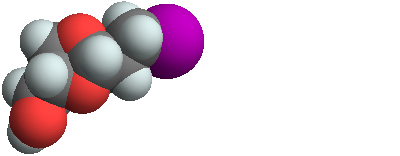
3D structure
Basic properties
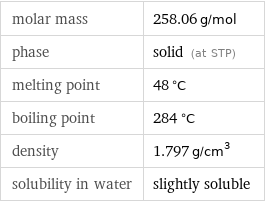
molar mass | 258.06 g/mol phase | solid (at STP) melting point | 48 °C boiling point | 284 °C density | 1.797 g/cm^3 solubility in water | slightly soluble
Units

Solid properties (at STP)
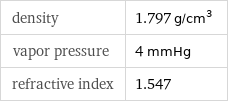
density | 1.797 g/cm^3 vapor pressure | 4 mmHg refractive index | 1.547
Units

Thermodynamic properties

critical temperature | 766 K critical pressure | 3.97 MPa (at STP)
Chemical identifiers
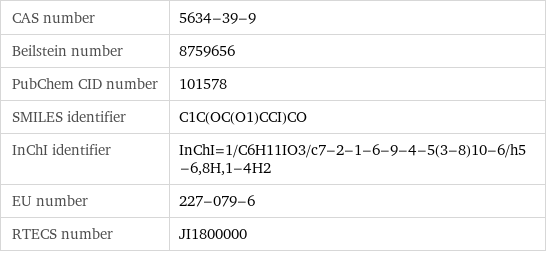
CAS number | 5634-39-9 Beilstein number | 8759656 PubChem CID number | 101578 SMILES identifier | C1C(OC(O1)CCI)CO InChI identifier | InChI=1/C6H11IO3/c7-2-1-6-9-4-5(3-8)10-6/h5-6, 8H, 1-4H2 EU number | 227-079-6 RTECS number | JI1800000
Toxicity properties

RTECS classes | tumorigen | mutagen